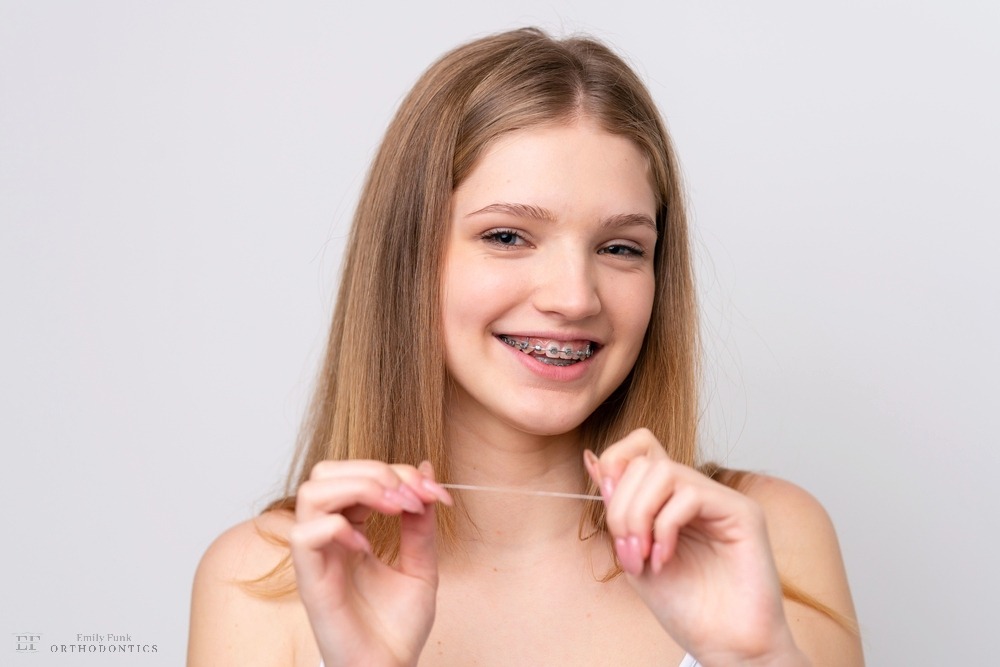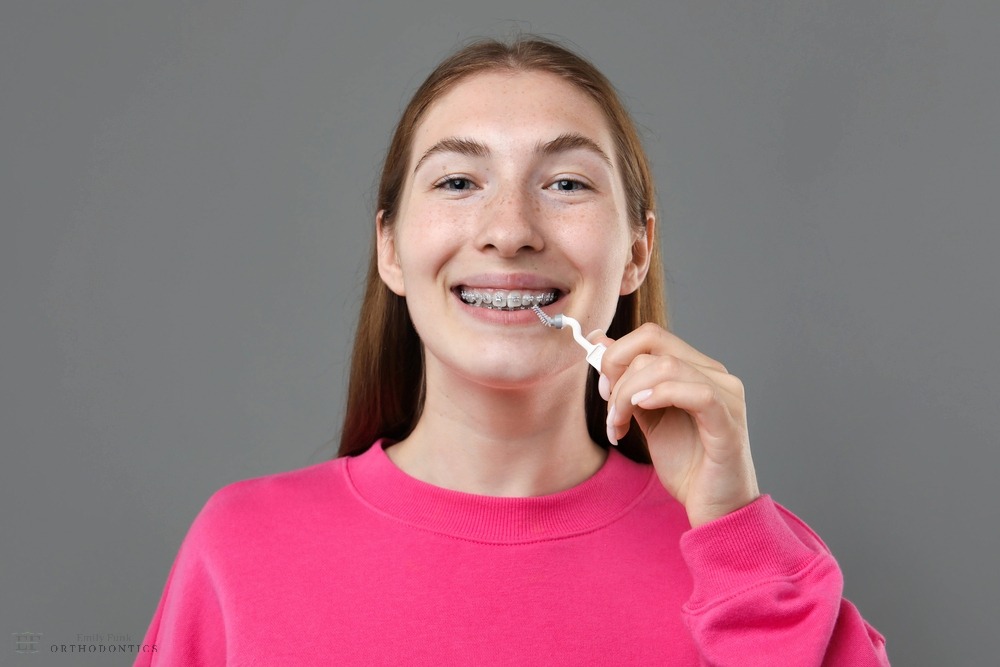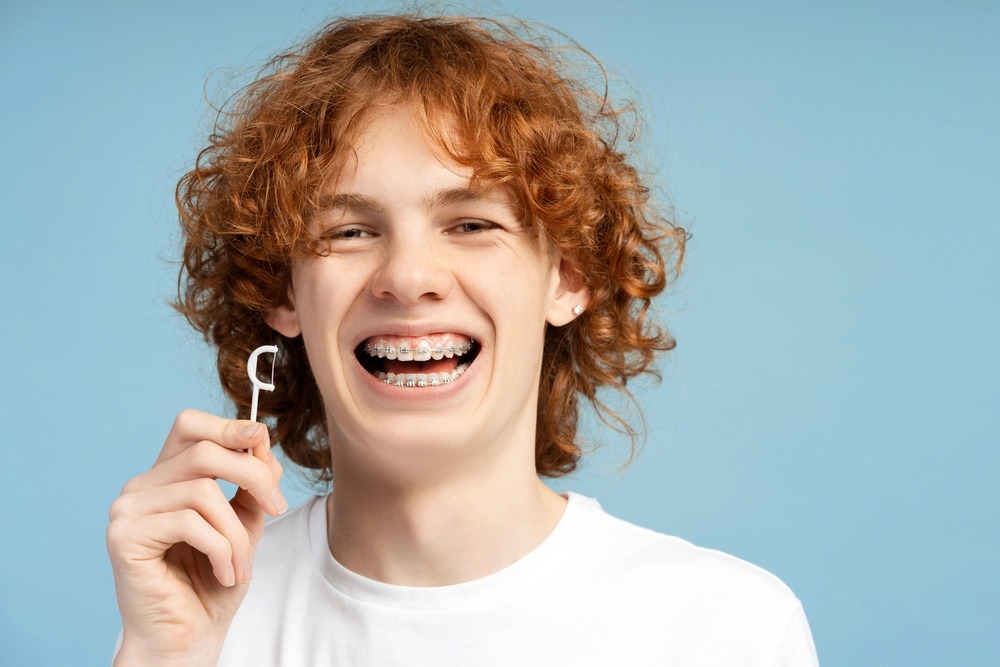Do you need help knowing how to floss with braces in Chester Springs, PA? You’re not alone! Braces can make it harder to clean your teeth because the wires and brackets trap food particles. If food and plaque build up, they can cause gum issues or even tooth decay.
Read the rest of this article to see how easy flossing with braces can be once you know the right tools and simple daily habits.

Why Flossing with Braces Is Essential
Braces straighten your teeth but create small wire gaps where food and plaque can hide. These hidden areas become breeding grounds for bacteria if not cleaned properly. Over time, this can lead to cavities, gum disease, or other hygiene issues. While brushing is important, it cannot fully clean around the brackets and wires. Flossing is a necessary part of a complete maintenance routine to remove food particles and plaque, keeping your gums and teeth healthy during orthodontia.
Helpful Tools for Flossing with Braces
Flossing with braces is easier when you have the proper tools. These specialized options can simplify your daily cleaning instructions and make flossing more effective:
Floss Threaders
Floss threaders are flexible tools that guide floss under the wires of your braces. They are simple to use and work well for beginners learning to floss with braces. Threader floss helps you keep your brackets and wires safe while ensuring a thorough clean.
Water Flossers
A water flosser, also known as an oral irrigator, uses a stream of water to flush out food and plaque from around braces. These flossing tools are perfect for people with sensitive gums.
Superfloss
Superfloss is pre-cut floss with a stiff end for threading under wires. It also has a spongy section that is great for cleaning along the gumline and around brackets. Superfloss is highly recommended for managing your dental hygiene routine during orthodontic care.
Interdental Brushes
Interdental brushes, also called proxy brushes, are small, cone-shaped brushes. They fit between wires, brackets, and teeth, making them ideal for cleaning tight spaces. They’re a great addition to your cleaning tools because of their convenience and versatility.
Floss Picks
Floss picks are pre-threaded tools with a sturdy handle, making them quick and easy to use. They simplify flossing on busy days and help you stick to a regular cleaning routine. Some floss picks are specially designed for braces, ensuring effective cleaning around your orthodontic appliances.
Where to Buy Flossing Tools
Flossing tools like floss threaders, water flossers, and proxy brushes are easy to find in Chester Springs, PA. Look for them at local drugstores or order them online for convenience. Your orthodontist can also recommend the best tools or provide products designed for braces.
How to Floss with Braces: A Simple Step-by-Step Guide
Flossing with braces gets easier the more you practice. Follow these steps to keep your teeth, braces, and gums clean:
Step 1: Get Your Floss Ready
Cut a strand of floss about 18 inches long. Using a floss threader, slide the floss under the wire of your braces and position it between two teeth. Hold the floss tightly so it doesn’t slip while you clean. Move slowly to avoid pulling on the wire or hurting your gums.
Step 2: Clean Each Tooth
Wrap the floss in a “C” shape around one tooth. Gently move it up and down along the tooth and slightly under the gumline. Be careful not to snap the floss against your gums or bend your wires.
Step 3: Add a Water Flosser to Your Routine
After flossing with string floss, use a water flosser. Adjust the water pressure so it feels comfortable and aim the stream at the gaps between wires, teeth, and brackets. Using a water flosser helps remove any stubborn food particles.
Step 4: Brush Your Teeth After Flossing
Finish up by brushing your teeth. Use a soft-bristled toothbrush to clean around brackets, wires, and along the gumline. Use fluoride toothpaste for strong teeth and rinse with a fluoride mouthwash to reduce plaque buildup and prevent cavities.
Brace-Specific Flossing Tips
Different types of braces require slightly different cleaning techniques:
- Metal Braces: Gently floss under the wires without bending them.
- Clear Braces: Use soft motions to avoid chipping the brackets.
- Lingual Braces: Interdental brushes and water flossers work best.
- Self-Ligating Braces: These braces are simpler, but they still need regular cleaning around the wires.
Common Flossing Challenges and How to Solve Them
Flossing with braces might feel frustrating at times. Here are some common challenges and how to handle them:
Tender or Sore Gums
If your gums feel sore when flossing, try rinsing your mouth with warm salt water to relax and soothe them. Over time, your gums will become stronger and flossing will hurt less.
Tight Spaces Between Teeth
Flossing tightly spaced teeth can feel tricky. Use waxed floss, superfloss, or a water flosser to make cleaning these spots easier while preventing floss from tearing or snapping.
Busy or Hectic Schedules
Life gets busy, but tools like orthodontic floss picks or water flossers save time without sacrificing your dental hygiene routine. They make it easier to follow through with your flossing habits every day.
Caring for Your Smile After Braces
Once your braces are removed, it’s important to stay on top of your dental hygiene routine to keep a healthy smile:
Wear Your Retainer
A retainer will keep your teeth from moving back to their original position. Follow your orthodontist’s instructions on when and how to use it. Wearing it daily helps protect your new smile and keeps your teeth straight.
Keep Brushing and Flossing Daily
Continue your daily oral hygiene routine; brushing twice a day and flossing once a day keeps your smile bright and healthy. According to Dr. Natalie Yang, a professional orthodontist in Vacaville, CA, maintaining a consistent brushing and flossing routine after braces removal ensures long-term results and prevents your teeth from shifting.

Expert Orthodontic Care at Emily Funk Orthodontics
At Emily Funk Orthodontics in Chester Springs, PA, Dr. Emily Funk and her team focus on your oral health during every step of your orthodontic treatment. We offer advice on flossing methods, tools like floss threaders and water flossers, and tips for maintaining proper hygiene while wearing braces. Schedule regular appointments to ensure your oral hygiene routine is effective throughout treatment.
Start Flossing Today
Don’t let braces keep you from maintaining excellent oral health! With tools like floss threaders, proxy brushes, floss picks, and water flossers, cleaning your braces and teeth becomes simple and stress-free. Visit Emily Funk Orthodontics in Chester Springs, PA, for more tips and expert care. Schedule a consultation and begin your journey to better oral hygiene!
About The Authors
Dr. Emily Funk-Reynolds – Orthodontist in Chester Springs, PA
Dr. Natalie Yang – Orthodontist in Vacaville, CA
Frequently Asked Questions
Is it normal to not be able to floss with braces?
Yes, it’s totally normal to find flossing hard when you first get braces. Those wires and brackets make it tricky to reach between your teeth. Lots of people struggle with it at first. It just takes a little practice and patience to get used to. You can use special tools like floss threaders, interdental brushes, or even water flossers to make it easier.
How many times are you supposed to floss with braces?
Try to floss at least once a day when you have braces. It might take more time than usual, but it’s worth it! Daily flossing helps remove food and plaque that get stuck in the wires and between your teeth. You can use floss threaders or orthodontic floss to make it easier.
Is it okay to miss a day of brushing with braces?
It’s best not to skip brushing when you have braces. Those brackets and wires trap food and plaque fast, which can lead to cavities, stains, or gum problems. Even missing one day can let bacteria build up. Try to brush at least twice a day, and after meals if you can.
 Free Consult
Free Consult